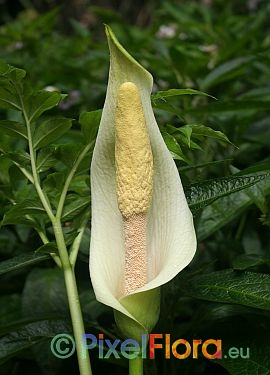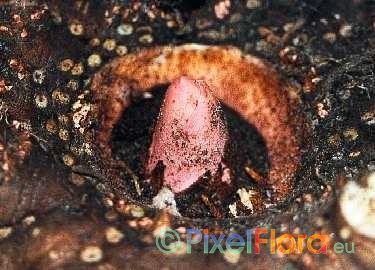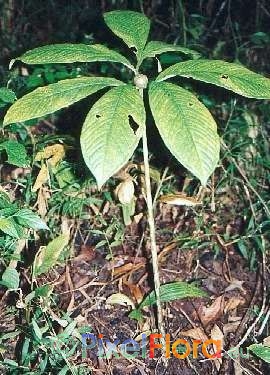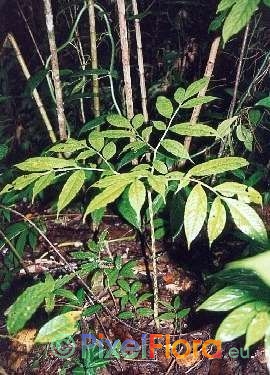|
Origin and Habit
  The genus Amorphophallus (commonly known as "Titan Aroids") is made up of some 170 herbaceous species at present. The majority of Amorphophallus species is located in subtropical and tropical lowlands of forest margins and open, disturbed spots woods throughout Asia. Few species are found in Africa (e.g. Amorphophallus abyssinicus, West to East Africa), Australia (represented by a single species, namely Amorphophallus galbra, Queensland, North Australia and Papua New Guinea), and Polynesia respectively. Few species such as Amorphophallus paeoniifolius (Madagascar to Polynesia) serve as a food source throughout the Asian region for their tubers and have been cultivated in the tropics for a long time. A complete list of Amorphophallus species including many photos of Titan Aroids is available from the website of the
International Aroid Society. The genus Amorphophallus (commonly known as "Titan Aroids") is made up of some 170 herbaceous species at present. The majority of Amorphophallus species is located in subtropical and tropical lowlands of forest margins and open, disturbed spots woods throughout Asia. Few species are found in Africa (e.g. Amorphophallus abyssinicus, West to East Africa), Australia (represented by a single species, namely Amorphophallus galbra, Queensland, North Australia and Papua New Guinea), and Polynesia respectively. Few species such as Amorphophallus paeoniifolius (Madagascar to Polynesia) serve as a food source throughout the Asian region for their tubers and have been cultivated in the tropics for a long time. A complete list of Amorphophallus species including many photos of Titan Aroids is available from the website of the
International Aroid Society.
As in other related genera within the broad Aroid family (Araceae), such as Arisaema, Dracontium, and Typhonium, most species develop a large, subterranean round to elongated tuber or fleshy rhizome, which serves as a storage organ and may gain up to 60kg and more in the tallest species, such as Amorphophallus hewitii (Sarawak, East Malaysia),Amorphophallus titanum (Sumatra, Indonesia), and Amorphophallus gigas (Sumatra, Indonesia). In most species a single, long-stemmed, umbrella-like, dissected leaf is developed each growing cycle, resembling almost a small tree in the giant members of this genus. In certain species, such as Amorphophallus bulbifer (widespread throughout India) a secondary leaf may develop under favorable growing conditions.
 On maturity plants produce a usually single inflorescence, composed of a sometimes very colorful outer spathe (pseudo petal) and an inner spadix, which may be shorter or protruding the spathe, usually in a different color. The latter hosts the quite small male and female flowers at its base. On the day of opening the female flowers are receptive and the inflorescence produces a sometimes very, rather unpleasant strong scent, which is very attractive for its main pollinators, such as flies, and certain beetles. On the second day the female flowers are not receptive anymore, whereas the male flowers release their pollen. After successful pollination the female flowers develop into some colorful berries, which may contain 1 to rarely 2 or 3 seeds each. In most species berries are bright orange to scarlet, whereas some may be bluish-lilac (Amorphophallus kiusianus, South Japan, East China, and Taiwan) or rarely whitish-green to yellowish-green. The ovate to elliptic seeds are somehow fleshy and are dispersed by birds. On maturity plants produce a usually single inflorescence, composed of a sometimes very colorful outer spathe (pseudo petal) and an inner spadix, which may be shorter or protruding the spathe, usually in a different color. The latter hosts the quite small male and female flowers at its base. On the day of opening the female flowers are receptive and the inflorescence produces a sometimes very, rather unpleasant strong scent, which is very attractive for its main pollinators, such as flies, and certain beetles. On the second day the female flowers are not receptive anymore, whereas the male flowers release their pollen. After successful pollination the female flowers develop into some colorful berries, which may contain 1 to rarely 2 or 3 seeds each. In most species berries are bright orange to scarlet, whereas some may be bluish-lilac (Amorphophallus kiusianus, South Japan, East China, and Taiwan) or rarely whitish-green to yellowish-green. The ovate to elliptic seeds are somehow fleshy and are dispersed by birds.
Cultivation
 In culture most species are easily grown in any humus-rich, rather organic, well drained and well aerated soil. The majority of Amorphophallus species can be grown at some 20°C (optimal 25°C) during summer in a semi-moist soil in a partially shaded spot with protection from direct sunlight, especially during hours at midday.Few tropical species, such as the famous Amorphophallus titanum from Sumatra require a higher average temperature of some 25°C throughout their growing cycle. Few species have a prolonged growing cycle which exceeds 12 months, or are even evergreen, however in most species the single leaf starts to yellow in autumn. At this point plants should be kept absolutely dry at a minimum of some 10°C. The tuber in immature specimens may increase its weight threefold in a single season. Most tubers stay dormant for some 3 to 7 months. Thus they are preferably moved to a warmer spot with beginning of spring, the increase in temperature during daytime stimulates in most Amorphophallus species new growth. As soon as the new leaf appears from the center of the tuber, plants shall be watered carefully again. Most Amorphophallus species flower before the leaf unfolds, whereas some may rest for the entire year. As roots emerge in most species primarily from the upper part of the tuber, it shall be planted deep enough so that the roots may develop freely. Three times the size of the tuber is a suitable depth for most species. In culture most species are easily grown in any humus-rich, rather organic, well drained and well aerated soil. The majority of Amorphophallus species can be grown at some 20°C (optimal 25°C) during summer in a semi-moist soil in a partially shaded spot with protection from direct sunlight, especially during hours at midday.Few tropical species, such as the famous Amorphophallus titanum from Sumatra require a higher average temperature of some 25°C throughout their growing cycle. Few species have a prolonged growing cycle which exceeds 12 months, or are even evergreen, however in most species the single leaf starts to yellow in autumn. At this point plants should be kept absolutely dry at a minimum of some 10°C. The tuber in immature specimens may increase its weight threefold in a single season. Most tubers stay dormant for some 3 to 7 months. Thus they are preferably moved to a warmer spot with beginning of spring, the increase in temperature during daytime stimulates in most Amorphophallus species new growth. As soon as the new leaf appears from the center of the tuber, plants shall be watered carefully again. Most Amorphophallus species flower before the leaf unfolds, whereas some may rest for the entire year. As roots emerge in most species primarily from the upper part of the tuber, it shall be planted deep enough so that the roots may develop freely. Three times the size of the tuber is a suitable depth for most species.
Several species vegetatively propagate as well, either by stoloniferous tubers (as in Amorphophallus albus, China and Amorphophallus konjac, South China and Vietnam), rhizomatous offsets (Amorphophallus krausei, (Myanmar, North and West Thailand, and Yunnan Province in China), small to medium sized bulbils formed between leaflets (Amorphophallus bulbifer and Amorphophallus muelleri (West Thailand, Andaman Islands in India, Sumatra, Java, Timor, and Sulawesii in Indonesia), and small adjacent tubers (as in Amorphophallus odoratus, syn. Amorphophallus dunni, South East China and Amorphophallus paeoniifolius). These shall stay attached to the main tuber until they can be separated easily and repotted as a new individual.
Sowing
 Most Amorphophallus are easily raised from seed. Seeds are potted some 1 cm deep in the same soil mix as mentioned above, which is kept only slightly moist. The optimal temperature is some 25°C at day and some 20°C at night. Hence most seedlings occur in a period of some 2 to 6 weeks, some may take a couple of weeks more. If sowed in autumn or winter rarely certain seeds of various species seem to be dormant and do not germinate before next spring. Most seedlings of Titan Aroids show a prolonged growing cycle in comparison to older and mature specimens within the same species. Thus pots should kept warm in partial shade throughout the year as long as seedlings are “green”, i.e. as long as they have a leaf. Several seedlings may make not only one, but two or more leaves before they enter dormancy for the first time. In general young dormant tubers from seedlings shall not be kept completely dry, as they may desiccate easily. They prefer a slightly moist soil at a minimum of some 20°C. Most Amorphophallus are easily raised from seed. Seeds are potted some 1 cm deep in the same soil mix as mentioned above, which is kept only slightly moist. The optimal temperature is some 25°C at day and some 20°C at night. Hence most seedlings occur in a period of some 2 to 6 weeks, some may take a couple of weeks more. If sowed in autumn or winter rarely certain seeds of various species seem to be dormant and do not germinate before next spring. Most seedlings of Titan Aroids show a prolonged growing cycle in comparison to older and mature specimens within the same species. Thus pots should kept warm in partial shade throughout the year as long as seedlings are “green”, i.e. as long as they have a leaf. Several seedlings may make not only one, but two or more leaves before they enter dormancy for the first time. In general young dormant tubers from seedlings shall not be kept completely dry, as they may desiccate easily. They prefer a slightly moist soil at a minimum of some 20°C.
Pests and Diseases
Especially dormant tubers are sometimes prone to fungal or bacterial infections and rotting, especially in moist soil at low temperatures. If an infection is detected (parts of the tuber start to get slimy or mashy), an effort of rescue may be started by generously cutting away all infected parts. The rest of the tuber shall hence be dusted with some power fungicide and kept absolutely dry for several days before being repotted in a rather dry soil. In general and as a prevention measure against fungal infections older plants should not be irrigated during dormancy as long as the new leaf does not emerge. A second pest which may especially infect plants in growth are nematodes (small almost transparent worms some 2mm to 4 mm in length). All dormant tubers shall be repotted every other year and shall be inspected for these insects. If they are detected, an all-purpose systemic pesticide should be applied as directed for at least two growing seasons.
Resource
A selection of seeds and dormant tubers of various Amorphophallus species, such as Amorphophallus albus, Amorphophallus bulbifer, Amorphophallus kachinensis, Amorphophallus kiusianus, Amorphophallus konjac, Amorphophallus longituberosus, Amorphophallus macrorhizus, Amorphophallus odoratus, and Amorphophallus yunnanensis are available from our online store at:
www.rareplants.eu/shop
[Download this document as PDF-file:
 . Adobe Acrobat Reader for viewing PDF is available in English for free here.] . Adobe Acrobat Reader for viewing PDF is available in English for free here.] All information on this page is presented without any guarantee.
|